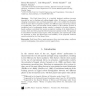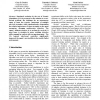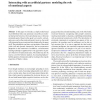265 search results - page 15 / 53 » Learning to Drive and Simulate Autonomous Mobile Robots |
ICRA
2007
IEEE
14 years 2 months ago
2007
IEEE
— Hierarchical state machines have proven to be a powerful tool for controlling autonomous robots due to their flexibility and modularity. For most real robot implementations, h...
AGENTS
2001
Springer
14 years 5 days ago
2001
Springer
Rodents possess extraordinary navigation abilities that are far in excess of what current state-of-the-art robot agents are capable of. This paper describes research that is part ...
AROBOTS
2005
13 years 7 months ago
2005
The Dual Smart Drive is a specially designed nonlinear actuator intended for use in climbing and walking legged robots. It features a continuously changing transmission ratio and d...
CEC
2005
IEEE
13 years 9 months ago
2005
IEEE
Simulated evolution by the use of Genetic Algorithms (GA) is presented as the solution to a twofaceted problem: the challenge for an autonomous agent to learn the reactive componen...
BC
2008
13 years 7 months ago
2008
In this paper we introduce a simple model based on probabilistic finite state automata to describe an emotional interaction between a robot and a human user, or between simulated a...



